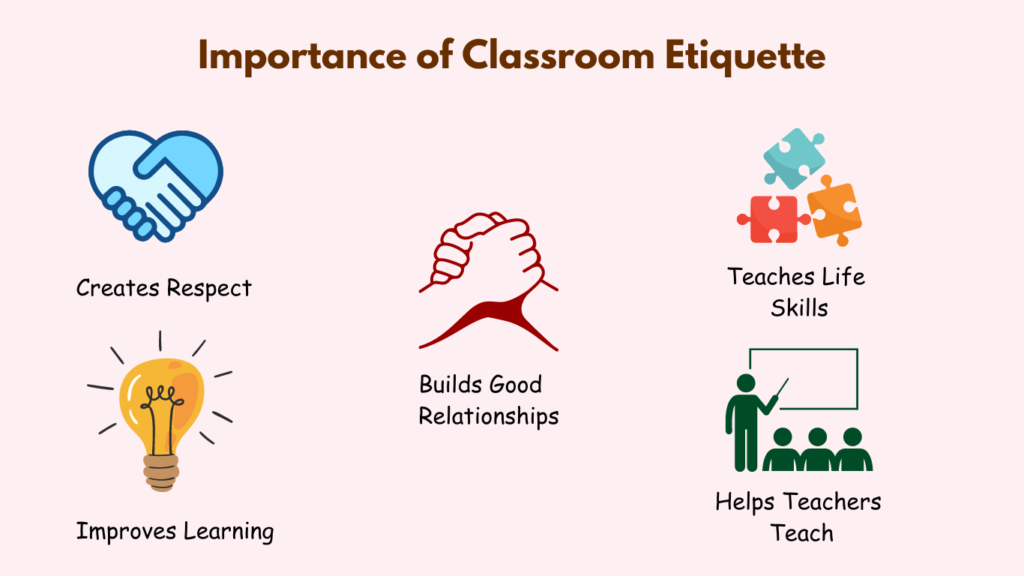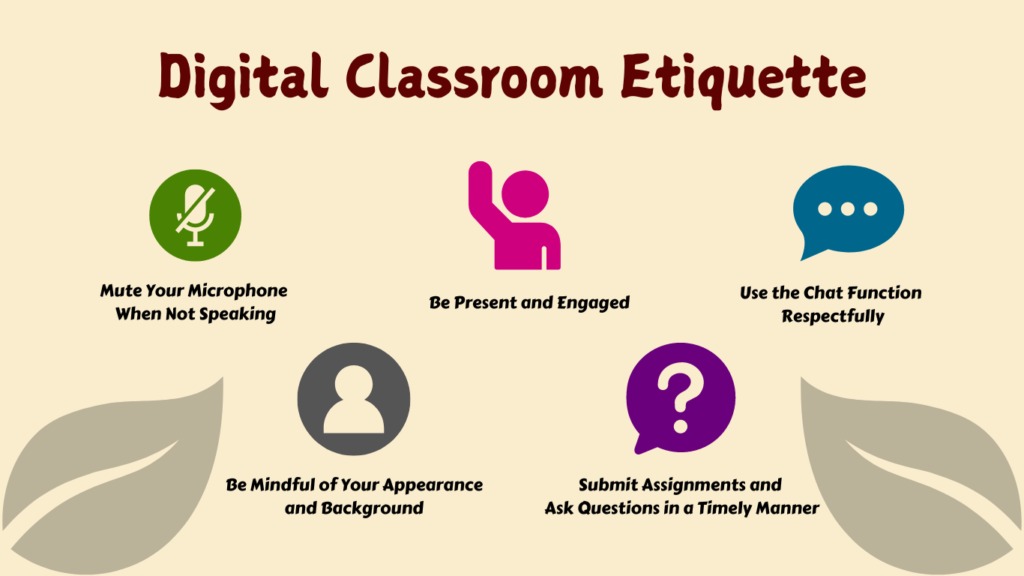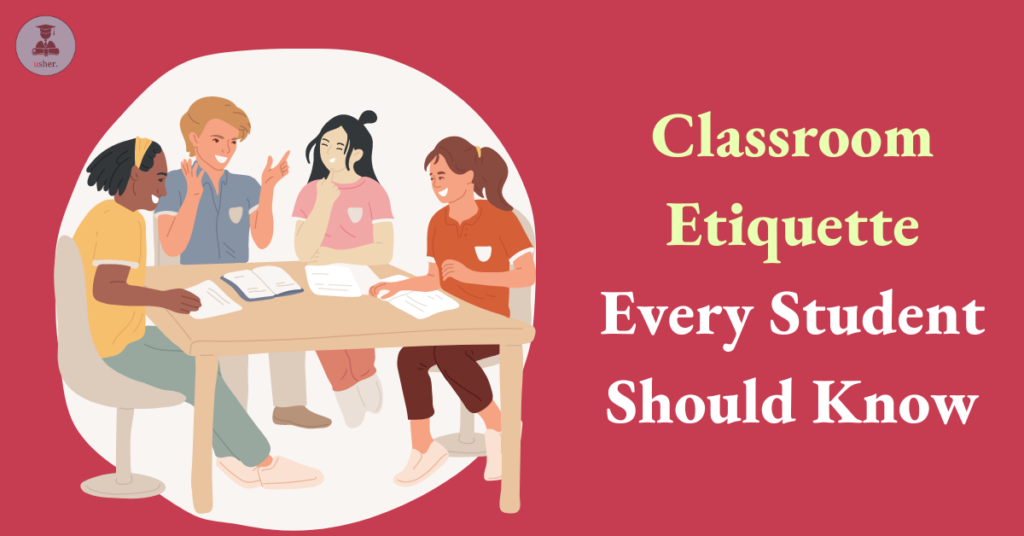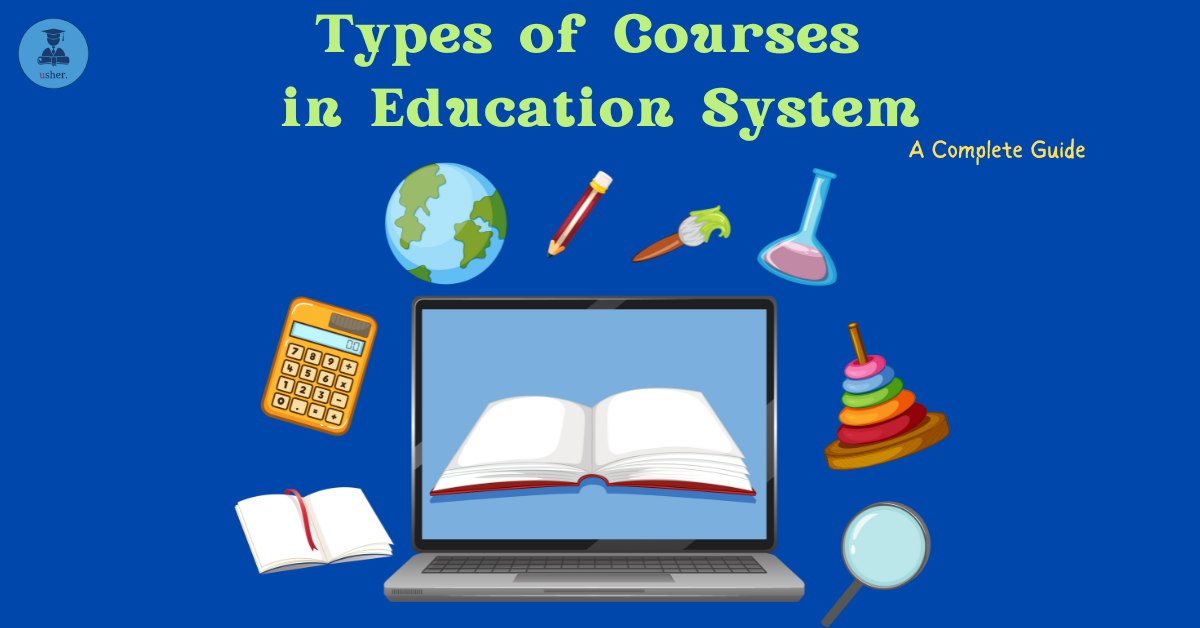Ever wondered why some classrooms are better for learning than others?
Why is it that in some classrooms, students are fully engaged, while in others, distractions seem to rule the day?
The answer often lies in something subtle but critical called “Classroom Etiquette”.
What is Classroom Etiquette?
Classroom etiquette refers to the behaviour and manners that students should exhibit while in a learning environment, such as being respectful to the teacher and other classmates.
By following proper classroom etiquette, students can create a positive and conducive atmosphere for learning, leading to better academic performance and overall success.
Classroom etiquette is more than just rules; it’s about creating a respectful and harmonious environment for both students and teachers.
Importance of Classroom Etiquette
Classroom etiquette is important because it helps create a positive and respectful environment where everyone can learn better. When students follow good manners in class, like being on time, listening carefully, and treating others with respect, it makes learning easier for everyone.
Here are some key reasons why classroom etiquette matters:
- Creates Respect: It shows respect for teachers and classmates. When students behave well, it makes the classroom a more pleasant place for everyone.
- Improves Learning: A quiet and focused classroom helps students concentrate and understand the lessons better. Fewer distractions mean more learning.
- Builds Good Relationships: Etiquette helps students get along with each other. Respecting others’ opinions and personal space makes the class a friendly place.
- Teaches Life Skills: Good manners in class prepare students for the future. Skills like listening, working well with others, and being responsible are useful in life and work.
- Helps Teachers Teach: When students follow etiquette, teachers can focus on teaching instead of managing bad behaviour. This leads to better lessons and a more successful learning experience.
In short, classroom etiquette helps everyone feel respected, focused, and ready to learn.

Etiquette to Follow Before Entering the Class
Good classroom etiquette starts before you even walk through the door.
A few pre-classroom etiquette are:
- Being Prepared
Being prepared is one of the first signs of respect toward your teacher and fellow students. Preparation means more than just having a pen and notebook.
It means completing any assigned readings or homework and mentally preparing to engage in the class discussion.
Imagine walking into a class where no one has done the reading.
The teacher asks questions, but no one can contribute.
How productive can that class be?
Now, imagine the opposite—a room where students are engaged, informed, and ready to dive into the material.
The difference is striking. Being prepared is not just about following the rules; it’s about contributing to the learning environment in a meaningful way.
- Being Punctual
Arriving on time is one of the simplest yet most important aspects of pre-classroom etiquette. Walking in late not only disrupts the lesson but also sends a signal that you don’t value the time of your peers or teacher.
Consider this scenario: A student walks in late during a critical moment of a lecture, rustling papers and searching for a seat. The teacher has to pause, other students lose focus, and the momentum of the lesson is broken.
Now imagine the same class where everyone arrives on time, settled, and ready to learn. Punctuality creates an atmosphere of respect and efficiency.
Being on time also helps you. It gives you a chance to settle down, focus, and mentally prepare for the lesson. It’s a small act of discipline that sets the tone for the rest of the class.
- Technology Etiquette
Technology is an integral part of modern classrooms, but it requires careful management. Smartphones, tablets, and laptops can enhance learning when used correctly, but they can also become significant distractions.
Before class starts, ensure your phone is on silent or turned off.
If laptops are allowed, use them only for note-taking or class-related tasks. Scrolling through social media or playing games not only distracts you but also sends a message that you’re not engaged with the class.
Show respect by using technology wisely, contributing to a focused and respectful learning environment.
Classroom Etiquette to Follow
Let us discuss basic classroom etiquette students should follow to create a positive and productive learning atmosphere.
1. Active Listening
Active listening is one of the most important aspects of classroom etiquette.
It involves paying full attention to the speaker (whether it’s the teacher or a fellow student) and engaging with the material.
This means not interrupting, nodding in agreement, and asking relevant questions when appropriate.
Active listening helps you absorb the information being presented and shows the speaker that you respect their words and ideas.
2. Respect Others’ Opinions
Classrooms are diverse spaces where people come from different backgrounds and have different perspectives.
It’s important to listen to and respect your classmates’ opinions, as this builds a positive and inclusive learning environment.
If you disagree, it’s important to voice your opinion without being rude or dismissive. Showing respect for different viewpoints encourages open discussions and creates a sense of community within the class.
3. Raise Your Hand to Speak
Raising your hand before speaking is a basic but important classroom rule.
It ensures that everyone has a chance to contribute to the conversation without interrupting others.
When multiple people speak at once, it becomes chaotic and hard for anyone to follow the discussion.
By raising your hand, you’re respecting the speaking order and showing courtesy to your classmates and teacher. This simple gesture also helps the teacher manage the class and ensures that everyone’s voice is heard.
4. Minimize Distractions
Classrooms are places for focus and learning, so it’s important to minimize distractions.
This means avoiding side conversations, keeping your phone silent, and staying focused on the lesson.
Distractions not only take away from your own learning but also disrupt the attention of those around you.
By staying engaged and attentive, you can make the most of your time in class and contribute positively to the learning environment.
5. Respect Personal Space
Respecting your classmates’ personal space is key to maintaining a comfortable classroom environment.
This means not touching other students’ belongings without permission, keeping a reasonable distance from others, and being mindful of how your actions affect those around you.
Personal space is more than just a physical area.
Respecting boundaries also means letting your friends say what they want without worrying about being judged. It makes a safe and helpful space where everyone can concentrate on learning.
6. Follow Instructions
You should carefully follow what your teacher says when they say it.
It’s important for everyone in the class to understand what the instructions mean.
If you don’t follow the rules, you might miss out on important information or assignments.
Paying attention to directions is important for both group projects and individual work. It also shows that you value the teacher’s authority and the learning process.
7. Clean Up After Yourself
Maintaining a clean and organised workspace is a basic courtesy in the classroom.
Whether it’s your desk, the materials you use, or common areas, always clean up after yourself.
Leaving trash, books, or other items scattered around not only creates a messy environment but also shows a lack of respect for the shared space.
Keeping things tidy helps everyone feel more comfortable and allows the class to function more efficiently.
8. Be Polite in Group Work
Group work is an essential part of many classroom activities, and it requires specific etiquette to be successful.
Politeness in group settings includes listening to everyone’s ideas, contributing your fair share, and not dominating the conversation.
A group project works best when each member feels valued and respected.
If there’s a disagreement, handle it calmly and constructively. Cooperation, rather than competition, should be the focus of group work, and politeness ensures that everyone has a chance to succeed.
9. Address Teachers Properly
It’s important to use respectful language and tone when addressing teachers, whether in person or through email.
For example, using the correct title, saying “please” and “thank you,” and speaking in a polite voice when talking to your teacher shows that you know the line between students and teachers.
In written communication, avoid overly casual language. Writing a clear, polite email (e.g., “Dear Ms. Smith, I have a question about the homework…”) helps maintain professionalism and ensures your message is taken seriously.
10. Use Technology Responsibly
Many classrooms now incorporate technology like laptops, tablets, and smartphones.
However, with this comes the responsibility of using these tools appropriately.
Technology should enhance your learning, not distract from it. If you’re allowed to use devices, make sure they’re used only for class-related tasks.
Playing games, texting, or browsing social media is disrespectful to the teacher and disrupts your focus.
Responsible technology use shows maturity and respect for the learning environment.
11. Stay Focused During Class
Staying focused during class is crucial for both your learning and the learning of those around you.
It means listening actively, participating when appropriate, and avoiding daydreaming or distractions.
There is less disruption in class and more learning for everyone when students pay attention.
You can also recollect information better and do better on tests if you stay focused.
12. Respect Classroom Rules
Every classroom may have specific rules set by the teacher or school, such as seating arrangements, dress codes, or specific behavior expectations.
Respect and obey these rules. These rules are designed to create an environment conducive to learning and to ensure that everyone feels safe and respected.
Ignoring or breaking classroom rules can create chaos and disrupt the learning experience for others. By following the rules, you contribute to a respectful and orderly classroom.
13. Be Kind and Supportive
Kindness is one of the most important aspects of classroom etiquette.
Treat your classmates with empathy and offer support when they need help.
Whether it’s sharing notes, helping a classmate with a difficult problem, or simply being encouraging, kindness helps build a positive classroom environment.
Classrooms should be spaces where students feel safe to express themselves and take risks in their learning.
Digital Classroom Etiquette
With the rise of online and hybrid learning, digital classroom etiquette has become a critical skill. In virtual classrooms, the same principles of respect and engagement apply, but there are some additional considerations.
First, ensure that you’re in a quiet space free from distractions when attending virtual classes.
1. Mute Your Microphone When Not Speaking
Background noise can be distracting in an online class, so always mute your microphone when you’re not speaking. This ensures that the class can proceed without interruptions from things like typing, talking, or other background sounds.
2. Be Present and Engaged
Even though you’re behind a screen, it’s important to stay focused and participate actively in the virtual classroom. Avoid multitasking, like checking social media or texting, as it distracts you from the lesson. Show your presence by responding to questions and contributing to discussions.
3. Use the Chat Function Respectfully
If your virtual class allows for a chat function, use it responsibly. Keep the messages on-topic, and avoid side conversations or unrelated comments. The chat feature is there for clarifying questions or engaging in class discussions, not for personal conversations.
4. Be Mindful of Your Appearance and Background
When attending a virtual class with video on, make sure you’re dressed appropriately for the setting, just as you would in a physical classroom.
Also, ensure your background is clean and professional to avoid distracting others.
If possible, use a neutral or virtual background to keep the focus on the lesson.
5. Submit Assignments and Ask Questions in a Timely Manner
In an online classroom, deadlines and class schedules are just as important as in-person classes. Submit your assignments on time and avoid waiting until the last minute to ask questions. It shows respect for the teacher’s time and allows for a smoother flow of the class.

Importance of Tone and Clarity in Emails
Written communication is a big part of digital classroom etiquette, especially when it comes to emailing teachers or classmates. Use proper greetings and sign-offs, keep your messages concise, and avoid using overly casual language.
For example, instead of writing “Hey, what’s the homework?”, try “Dear [Teacher’s Name], could you please clarify the homework assignment for tomorrow? Thank you.”
Clear, respectful communication helps maintain professionalism and avoids misunderstandings.
Impact of Good Etiquette on Learning
Good etiquette can have a lot of positive impacts on your learning experience. Some of the impacts are discussed below
1. Promotes a Positive Learning Environment
Good etiquette creates a respectful and supportive atmosphere in the classroom, where students feel valued and comfortable to participate. This encourages open discussions and collaborative learning.
2. Improves Focus and Reduces Distractions
When students follow proper classroom etiquette, like staying quiet and listening attentively, it minimizes disruptions and allows everyone to focus better on the lesson, leading to more effective learning.
3. Builds Stronger Relationships
Practising good manners and etiquette helps build trust and mutual respect between students and teachers, as well as among peers. Positive relationships foster cooperation, making group work and class discussions more productive.
4. Encourages Accountability
Good etiquette teaches students responsibility for their behaviour, punctuality, and participation. This sense of accountability improves their organisational skills and prepares them for future academic and professional settings.
5. Promotes Confidence and Participation
In an environment where etiquette is valued, students feel safe and encouraged to express their ideas, ask questions, and engage in classroom activities. This boosts their confidence and helps them take ownership of their learning.
6. Enhances Teacher-Student Communication
When students follow etiquette, such as raising their hand to speak or addressing teachers respectfully, it improves communication and reduces misunderstandings. This creates a smoother, more efficient classroom experience.
7. Reduces Stress for Teachers and Students
A classroom where etiquette is practised tends to be more organised and peaceful. Less disruptive behaviour means less stress for teachers, allowing them to focus on teaching, while students enjoy a more calm and structured learning environment.
8. Helps Develop Lifelong Social Skills
Good etiquette in the classroom doesn’t just benefit learning; it also helps students develop valuable social and communication skills that they will carry with them into adulthood, such as respect, patience, and cooperation.
Also read: Essential Student Etiquette You Must Follow!
Conclusion
In conclusion, practising good classroom etiquette is essential for creating a respectful and productive learning environment. From arriving on time to actively listening and respecting others’ opinions, these small actions contribute to a positive atmosphere where everyone can focus and thrive.
Good etiquette not only benefits academic success but also builds strong relationships, reduces stress, and encourages personal responsibility. Whether in a physical or digital classroom, these habits help students develop important social and communication skills that will serve them well in all areas of life. By prioritising respect and responsibility, students can make the classroom experience better for everyone.




